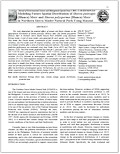| Journal Article |
 |
|
| Article Title | Modeling Future Spatial Distribution of Shorea palosapis (Blanco) Merr and Shorea polysperma (Blanco) Merr in Northern Sierra Madre Natural Park Using Maxent | | Author | Alfie M. Torres, Florencia B. Pulhin, Rodel D. Lasco, Cristino L. Tiburan, Jr. and Decibel F. Eslava | | Year | 2016 | | Journal Title | Journal of Environmental Science and Management Special Issue | | Volume | 1 | | Issue | 2016 | | Pages | 15-30 | | Call Number | JA00672-16 | | Keywords | Maximum Entropy
forest trees
climate change
species distribution
protected area |
|
| Abstract: |
| This study determined the potential effects of present and future climates on the geographical distribution of Shorea palosapis (Blanco) Merr. and Shorea polysperma (Blanco) Merr in Northern Sierra Madre Natural Park (NSMNP) using Maximum Entropy model. A total of seven models were generated for each species: one Climatic-Only model, four Partial models (combination of four variable groups with climatic variables), one Full model (used 30 original variables), and one Final model (used 18 uncorrelated variables after a series of variable reduction methods). The models’ relative predictive performance was evaluated using Area Under Curve (AUC) and True Skill Statistics (TSS). The Final model performed best both for S. palosapis (AUC = 0.8763; TSS = 0.8176) and S. polysperma (AUC = 0.8626; TSS = 0.8332). Analysis of variable importance revealed that species distributions were largely determined by climatic variables (34.35%) followed by anthropogenic variables (27.25%) and topographic variables (24.15%), while vegetation-related (7.58%) and edaphic variables (6.67%) had relatively lesser contribution. The probabilities of occurrence of the species changed and were found to benefit from future climate with increasing suitable habitat range. This study will provide practitioners with early warning estimates of how climate change may affect the distribution of endangered species. Furthermore, this will also assist decision-makers especially in mainstreaming climate change in the NSMNP management plan to better conserve potential suitable habitats of priority species. |
|
|
Download file(s): Click icon to download/open file.
|
| |
File Size |
Description |

|
1799 KB |
Softcopy |
|
|
|
| Viewed in 331 times. Downloaded in 399 times. |